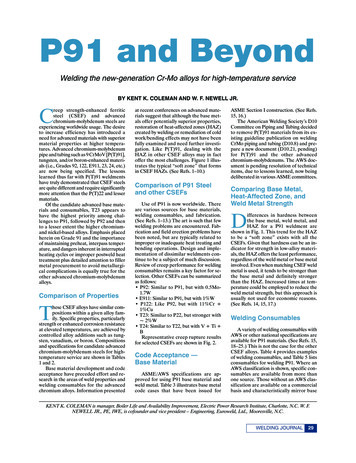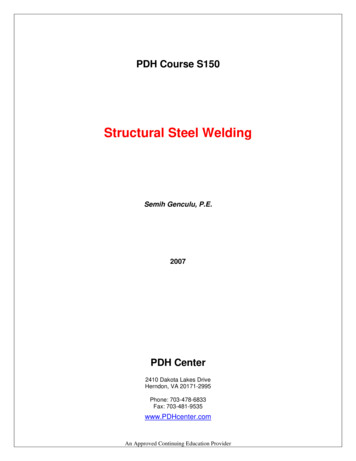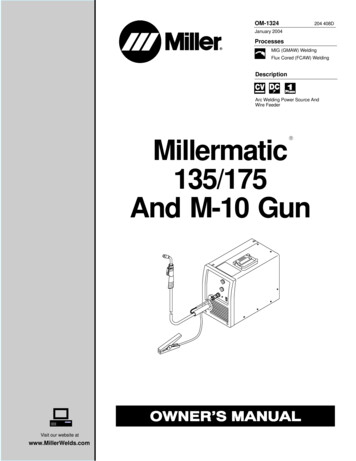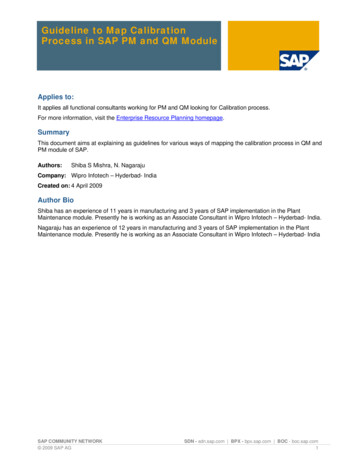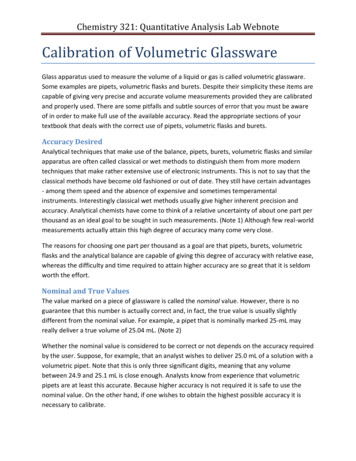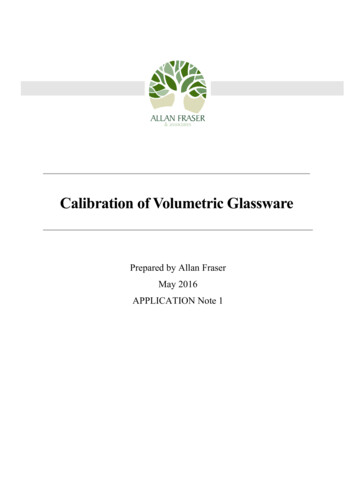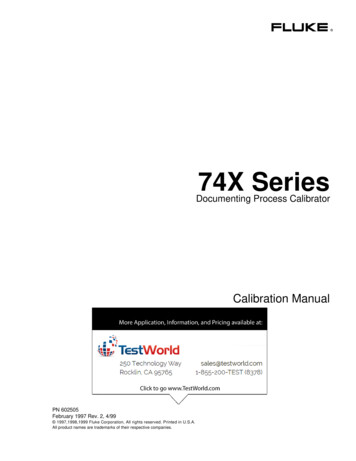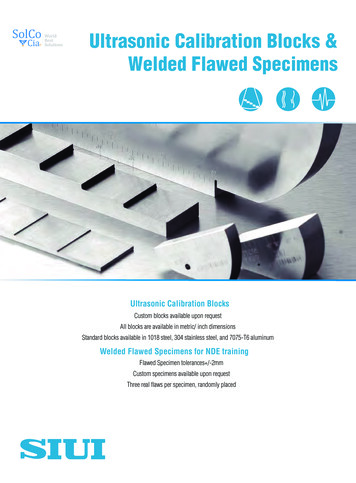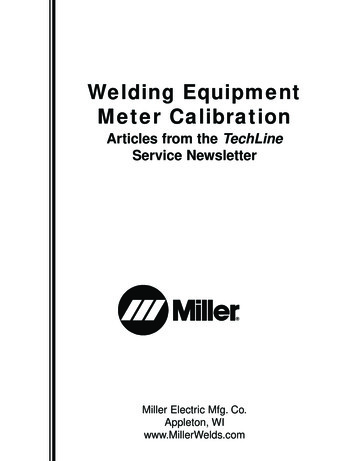
Transcription
Welding EquipmentMeter CalibrationArticles from the TechLineService NewsletterMiller Electric Mfg. Co.Appleton, WIwww.MillerWelds.com
PrefaceThe information in this booklet began as articles in the Miller Electric TechLinenewsletter, in 2000. A large number of follow-up requests led to the preparation ofthis booklet. We hope that these articles will help you understand what is needed tosuccessfully provide a calibration/certification service.Keep in mind that these articles give examples for instructional information only.This document contains information about factory calibration procedures using certified calibration instruments, and we are not responsible for usage outside MillerElectric Mfg. Co. If after reading this material you still have questions on specificMiller machines, please call 920-735-4505 during business hours. The calibrationforms and certificates used are not supplied by Miller Electric - you will need to purchase or create your own forms that are customized for you.As always, when working on welding equipment, follow all safety precautions in theOwner's and Technical Manuals. Have only qualified service technicians calibratewelding equipment.Thank you,Miller Electric Mfg. Co.
A NEWSLETTER FOR MILLER SERVICE AGENCIESAPRIL, 2000TechLineWhat You Need to Know about Meter Calibrationby Stan Hischke, Product Testing Calibration TechnicianIn this issue and the next issue,we'd like to discuss the variousaspects of meeting customer'sneeds concerning meter calibration. Have you received questions from your customers concerning ISO 9000, and the accuracy of the customer's meters? It'sStan Hischkepossible you may be asked just tocalibrate meters so that the customer knows theirmeters are accurate. Or, your customer may beconcerned with ISO 9000 certification.with meter calibration. Four topics will be coveredat this time:1. Calibration vs. Certification2. How often is calibration necessary?3. Resistive load vs. a welding arc4. Calibration Equipment SourceThe purpose of ISO 9000 standards is to ensurethat customers purchase products that aredesigned, built, tested, and sold under controlledconditions by trained people. Any customer,whether they represent a small company or a largemultinational company, minimizes their purchasingrisk by dealing with internationally recognized, ISO9000 registered suppliers.Calibration vs. CertificationWhen you calibrate a meter, you are simply verifyingthat the meter is accurate within tolerances, and ifnot, you adjust it to make it accurate. Certifying themeter means supplying a "paper trail" showing thatthe calibrated meter can now be traced back to theNational Institute of Standards and Technology (NIST),through your testing equipment. This simply meansthat you need a source to certify your meter also.ISO 9000 audits are concerned with the documentation that businesses have, and whether they arefollowing that documentation in their work procedures. It's up to the business to be responsible forthe step-by-step procedures of their documentation.Providing meter calibration services can be easierthan you think, and the goal of these articles is tohelp you provide this service to your customers.We'll begin by laying some of the groundwork tohelp understand what we are trying to accomplishDigital MetersAnalog MetersHow often is calibration necessary?When do you calibrate the customer's machinemeters? We recommend every year, hopefullycombined with a preventive maintenance package. Remember that for the procedures for ISO9000, you can make this interval any time periodyou want. The actual procedures made for ISO9000 documentation can come from a couple ofsources: the customer could give you the procedure,they mayask you to provide a procedure, or you may workon the procedure together with the customer.Continued
TechLineWhat You Need to Know about Meter CalibrationContinued from Page 1.In an article to follow, we will provide a sampleprocedure form that can be used as a guideline.The "bottom line" with a procedure is - make sureyou do what you say you are doing in the procedure.(If you say you are going to test the meters every twoyears, make sure you have a system in place toremind you when two years are up.)Also keep in mind that the time interval you andyour customer develop can be changed. Forexample, if you find that the meters are stayingaccurate and don't need to be adjusted year afteryear, there is nothing wrong with extending themeter calibration interval to every two years. Andthe opposite is also true, that if the meters areneeding calibration more often, you can changethe interval to every six months.Resistive load vs. a welding arcA welding arc is often referred to as a dynamicload, which simply means it is a changing load.Therefore, do not calibrate meters while welding.We strongly recommend using a resistive (constant)load. Both Miller Load Banks are excellent examplesof resistive loads. The LBP-350 Portable Load Bankwas specifically designed to help you calibratemeters in the field. (It weighs only 46 pounds.)Calibration Equipment SourceSome of you may already have a company that youpurchase your calibration equipment from, andthat's fine. If you do not have such a company,we'd like to introduce you to Transcat, a companythat we are very familiar with. Transcat calibratesand services all brands of calibration, test, andmeasurement instruments. They are headquartered in Rochester, New York, and have many locations across the nation. They can be reached at:Phone: 800-828-1470, or 716-352-9460FAX: 800-395-0543, or 716-352-1486Website: www.transcat.comE-mail: info@transcat.comTranscat not only sells test equipment, but willalso supply you with the "paper trail" you need foryour testing equipment certification. Transcat canalso calibrate your previously owned test equipment.We also can recommend a source, Q-Cee's ProductsDivision, that can supply you with the actual stickers you apply to the meters. These stickers will haveplaces for you to fill in the information needed, suchas the date calibrated, due date for the next calibration, and the calibrating person's identification. QCee's is located in Houston, Texas, and can be contacted by phone at 800-950-4922, or 707-575-3524.Sample Stickers from Q-CeeMiller Load Bank#902 804LBP-350 Portable Load Bank#043 329Editor's Note: Hopefully this first article raised yourinterest in calibrating and certifying welding equipment. In the next issue of TechLine, we will go intomore detail on calibration test equipment, and wewill provide information on a sample calibrationprocedure. If you have questions on the informationprovided here so far, or something else you'd like tosee in TechLine, please don't hesitate to drop us afax at TechLine, 920-735-4013. We appreciate yourinput!
A Newsletter for Miller Service AgenciesTMJuly, 2000What You Need to Know about Meter Calibration (Part 2)by Stan Hischke, Product Testing Calibration TechnicianStan HischkeWarning: When working onwelding equipment, follow allsafety precautions in theOwner's and Technical Manuals.Have only qualified service technicians calibrate welding equipment.In this follow-up article on meter calibrationand certification, we want to show you a sample procedure you might follow. Please locatethe insert page and keep it handy, as we'll bereferring to it.Let's say for example that your customer hasasked you to calibrate/certify their Miller CP302 welding power source. You have also beenprovided with a procedure written by theirQuality Assurance department. (See #1 oninsert.) At this time, read Steps A & B.We have filled out a sample sheet for Step B Ammeter. To calculate the percentage of error,follow this example from the Calibration DataSheet (#2 on insert):300 - 289.7 10.3:10.3300 .034333 3.4%In Step "C" fill out the Certificate ofCalibration (see #3 on insert). Add a sticker tothe CP-302, fill out the paperwork, and you'redone!We'll cover more on calibration in futureTechLines, but we'd like your input as to whatissues about calibration concern you. Why notdrop us a line on our fax machine? Contact usat: FAX 920-735-4013. Let us know what youthink about this calibration information so far,and what else we can cover that would be ofvalue to you. Thanks!CP-302 Power Sourcewww.MillerWelds.com
Example#1Date:3-10-99WELD UNIT METER CERTIFICATION PROCEDUREA. Voltmeter Certification1. Voltage readings shall be taken at the output studs of unit under test. Voltage readings shall be taken at open circuitvoltage with the Fluke 45.2. Verify that welder voltmeter reading is within or - 10% of standard meter reading. (If adjustment is required, seetechnical manual for each make and model.)3. Take readings at 10 volt intervals from min to max open circuit voltage.4. Record data on a Calibration Data Sheet (Form #686-8/99).B. Ammeter Certification1. Put certified shunt in series with Miller Load Bank #043329 and the output of unit under test.2. Monitor output of shunt with Fluke 45.3. Verify that welder ammeter reading is within or - 10% of standard meter reading. (If adjustment is required, seetechnical manual for each make and model.)4. Take readings at 100 amp intervals from 100 amps to max amperage output of unit under test.5. Record data on a Certification Calibration Data Sheet (Form #686-8/99).C. Certificate1. Fill out Certificate of Calibration form #189-3/99.2. Fill out a Certification sticker. Place sticker on front panel of unit under test.3. Customer receives the original Certificate of Calibration.4. File a copy of the Certificate, along with a copy of the order inquiry, and all of the completed data sheets.Example#2Form #686-8/99CALIBRATION DATA SHEETMake: MillerModel: CP-302Serial Number: HH0123456METER:CurrentX(ACDCX)or rimary Standard%ErrorN/AN/AN/AJoe TechnicianNot Applicable (N/A)Measurement289.7194.4101.6XWELDING MACHINE .8 1.6
For m #189-3/99Example#3 Certificate Of CalibrationMiller Model No. CP-302Miller Part No. 654321Serial No. HH0123456P.O. No. MW636Certificate No. 1(Your company Name Here) does hereby certify the above instrument was calibratedagainst standards maintained by (Your company Name Here) and meets or exceedsspecifications. The accuracy of these standards is directly traceable to the National Institute of Standards and Technology.2/10/2000Temperature: 72 FHumidity: 49% R.H.Certified By: Joe TechnicianCalibration Date:RecommendedRecalibration Date:2/10/2001Your Company Logo HereApplicable N.I.S.T. standards & datesFluke 45S/N 000000 Cal. 10/1/99T & M ShuntS/N 00000 Cal. 10/1/99
Calibration Questions and AnswersBy Stan Hischke, Product Testing Calibration TechnicianIn the last two issues of TechLine, we have presentedinformation on the subject of meter calibration.We've received some excellent feedback, and we'dlike to answer a few of your questions in this issue.In our next issue, we will address the subject ofmeter calibration of wire feeders.Q: Can I use a calibrated clamp-on meter to calibrate an ammeter, instead of a shunt?A: We do not recommend it. The readings on aclamp-on ammeter can be changed by changingthe position of the cable in the jaws of the clampon ammeter. A clamp-on is not accurate enough,and the readings are not repeatable. We recommend that you purchase a precision shunt. If youare using a Miller Load Bank, the Load Bank canbe used as your primary standard for ammetercalibration.Q: Do you have a good source for where I can purchase calibrated precision shunts?A: Yes, you can contact Empro Manufacturing ofIndianapolis, Indiana, at Phone 317-823-4478, orFAX 317-823-4835. Empro's model 5091-600-600is a 600 amp, 600 millivolt shunt. Every amp ofcurrent will output a 1 millivolt signal. Thismakes it very easy to read the output, ie, 100amps is read as 100 millivolts on your calibratedmultimeter.You can purchase a 5091-600-600 for 119.26.Empro will calibrate this shunt to .1% accuracy,and furnish you with an NIST certificate for 8.00. They will engineer special shunts for anyapplication. (Prices subject to change at somefuture date.)Q: Can I use a Load Bank to calibrate my welder'svoltmeter?A: No. Amperage is a series connection, and can bemeasured at any point in the circuit. Voltage isnot a series connection, and under a load, cablelosses can be significant. The only way to verifyvoltage is to take a reading at the output studswith your calibrated multimeter.Q: I have a Miller Load Bank. Can I take the ammeter out and send it somewhere for calibration?Q: Can I take the meters out of welders and sendthem somewhere for calibration?A: No. Keep in mind that the meter is only as accurate as the signal being fed it. All the wiring,shunt, P.C. board, etc., in the load bank or weldercan affect readings so you are really calibratingthe whole unit and not just the meter. You haveto calibrate the Load Bank or welder as a unit.Q: I have been asked about older welders that don'thave meters - how can I calibrate them?A: We do not recommend calibrating machines thatdon't have meters. Suggest to your customersthat they add meters if possible, or upgrade tomachines with meters if they are in need of calibration standards.Keep those good questions coming! You can fax yourquestion to TechLine, at 920-751-4013.
A Newsletter for Miller Service AgenciesTMApril, 2001What you Need to Know about Meter Calibration (Part 3)OrHow I Learned to Stop Worrying and Love the IPM MeterBy Stan Hischke, Product Testing Calibration TechnicianI'll bet many of you have checked wire feed speedby the old method of feeding out wire for six seconds and multiplying that length by ten. I know Ihave, and it does give a ballpark figure that can beuseful. This method however, would not be recommended for calibrating/certifying an inch perminute (IPM) meter.Instead, get yourself a good hand-held digitaltachometer. Transcat is a good source for test
needing calibration more often, you can change the interval to every six months. Resistive load vs. a welding arc A welding arc is often referred to as a dynamic load, which simply means it is a changing load. Therefore, do not calibrate meters while welding. We strongly recommend using a resistive (constant) load. Both Miller Load Banks are excellent examplesFile Size: 544KBPage Count: 12
